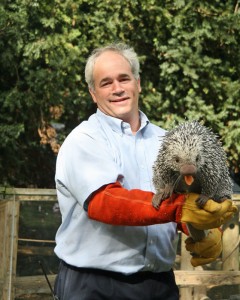Canton native John Linehan finds calling at the zoo
By Jay TurnerThe Franklin Park Zoo, a 72-acre treasure located in the heart of Boston, will celebrate its 100th anniversary this year, and no one could be more proud of this milestone than John Linehan, the zoo’s president and CEO since 2001 and a man whose own career at the zoo goes back more than three decades.
“I think we have an extremely bright future, and we still have a lot of room to grow,” said Linehan, a Canton native and a resident of neighboring Stoughton.
A self-proclaimed “animal and nature nut,” Linehan is actually the head of two zoos: Franklin Park and the 107-year-old Stone Zoo in Stoneham. Both were operated by the state Metropolitan District Commission (now the DCR) for many years before being turned over to Zoo New England — a private, nonprofit corporation — in the early 1990s.
Linehan began working at Franklin Park when it was still in the hands of the MDC, and over the years he has been both a witness and a contributor to the zoo’s evolution from a place of entertainment to a real center of conservation and education.
In a recent telephone interview with the Citizen, Linehan reflected on this transformation at both zoos as well as his own unique career path, while also sharing some of his fondest memories from his time growing up in the Ponkapoag section of Canton, where he developed both an appreciation for nature and a lifelong love of animals.
“I had an absolutely wonderful childhood in Canton,” recalled Linehan, who, together with his wife, Julie, have raised four children of their own.
From as far back as he can remember, Linehan had been fascinated with the natural world, and Ponkapoag, with its vast wooded areas and numerous ponds and streams, was an ideal playground for the young adventurer.
Accompanied by his trusty sidekick, a German shepherd named Colonel Joe, Linehan spent the large majority of his free time in the outdoors — exploring the surrounding woods, catching and releasing wild animals, and hiking in the nearby Blue Hills.
Most of his “pets” were short-term tenants, including turtles, frogs, raccoons, and even skunks. However, his family also had various dogs and cats, some of which were strays that Linehan had rescued. “I think we named all of our cats ‘Kitty,’” he remembered with a laugh.
Animals eventually became a real passion of his, and at one point, Linehan formed an animal club as a way to get some of his friends more involved. He also volunteered at the Trailside Museum in Milton, which was close enough for him to either walk or ride his bike to.
Linehan went on to Canton High School, where he played football under legendary Bulldogs coach Paul Therrian. He also played lacrosse on the school’s club team, and in his spare time he ran a landscaping/odd jobs business with his brothers.
When it came time to plan for college, Linehan considered a variety of programs, including zoology, before deciding on a wildlife studies program at the University of Maine. His father was disappointed at first, as he had hoped that Linehan would pursue a career in his engineering business. However, he came to embrace his son’s choice, and Linehan was thrilled to have found the perfect major.
“I just felt like I was so lucky to go to college for that,” he said, adding that his dream at the time was to pursue a wildlife career in a place like Africa or Alaska.
After graduating in 1980, Linehan accepted a temporary job in the bird area at Franklin Park Zoo, figuring he could use the experience and the income as he waited for better offers to materialize.
“At the time I had no intention of working at a zoo,” he said. “I really thought my stint there would be short-lived.”
Linehan readily admits that when he started at Franklin Park, he did not have the “best feeling about zoos.” And part of that negative perception grew out of his own visits to Franklin Park and Stone Zoo as a child.
“My recollections of the zoos of my childhood was sort of a dark, dank feeling — animals in small cages, cats pacing back and forth,” he said. “At Stone Zoo I remember the hardscaping of it; everything was concrete. It was a very sterile feeling.”
Nevertheless, things had already begun to change by the time Linehan had gotten his start at the zoo, and he quickly found himself advancing professionally, while also getting more opportunities to work with the animals — including tigers, gorillas, and bears.
He continued to climb the ranks and ended up spending time in nearly every position at both zoos, from head zookeeper to curator of mammals, to his current post as president and CEO.
“Thirty years later, I feel very lucky,” said Linehan, who now oversees the care and management of 1,000 animal residents and 155 zoo employees.
Arguably the biggest difference with today’s zoos, he said, is that they no longer simply collect and display as many species as possible; rather, they get to know each animal and study their needs.
They pay attention to natural social groupings, for instance, and they design habitats that mimic the animals’ natural surroundings. They have also introduced an environmental enrichment program, in which the zookeepers design challenges, including various “puzzle feeders,” which help to keep the animals mentally as well as physically stimulated.
He described one recent project where the zookeepers, with the help of a group of kids, made paper-mache zebras and hid meat inside as a special treat for the lions. They also designed a puzzle feeder for the giant anteater that required him to use his long tongue to reach the food.
Linehan said the keepers also do “incredible training programs,” and in some cases the animals will fight over which one gets to participate in the programs. Some animals have even been trained to receive immunizations, including one mother gorilla who holds her baby while the vet administers the shots.
“There’s a great trust relationship [between animals and humans],” said Linehan, adding that the “whole zoo community is a very collegial, sharing community.”
He is also very proud of the zoo’s many education initiatives, both on-site and in the schools, which focus on themes such as conservation, the interdependence of people and nature, and the ramifications of extinction.
In addition to teaching about conservation, Zoo New England also works closely with other accredited zoos and various wildlife groups on an assortment of local, regional and international conservation projects. Examples include the Northern Red-Bellied Cooter Headstart Program at Franklin Park, the Karner Blue Butterfly Habitat Restoration Project in New Hampshire, and the Panama Amphibian Rescue and Conservation project, a massive, international effort headed by ZNE’s head of veterinary services that aims to protect endangered frogs from the deadly chytrid fungus.
The zoo is also involved in efforts to protect gray wolves in Mexico, cranes in Russia, and snow leopards in south and central Asia, among other projects.
“Not many people know about all of this field conservation,” acknowledged Linehan. “But really that’s the work that’s at the heart and soul of what we do.”
Of course, Linehan’s job does have its drawbacks, and chief among them is the limited interaction he has with the animals, which nowadays can occur once a week or sometimes even less.
“That part of it can be frustrating,” he said, “but ultimately it’s very satisfying because I’m getting to move this organization to where it’s doing what I know it can and should be doing.”
On the one hand, that means attracting people to the zoo as visitors and as members, and as the head of what is now an “entrepreneurial operation,” Linehan accepts this as a “very necessary component of [his] job.”
However, it is when they walk through those gates that the real work begins, and for Linehan, it’s the reason he has stayed in one place all of these years — and the reason for all of those countless excursions decades earlier in the Ponkapoag woods.
“I really want the [zoo] visits to be effective in sensitizing people to the needs of nature and to help them understand their relationship to it,” he said. “In the end, it’s about getting people to really appreciate the wonders of nature and how incredible these animals are.”
Short URL: https://www.thecantoncitizen.com/?p=11175











